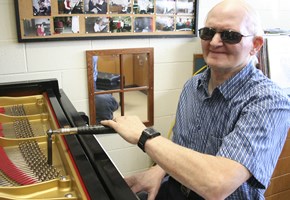Any way you look at it, Arthur Barney has had a long, successful career as a piano tuner and repairman.
He’s tuned pianos for Ray Charles, Burton Cummings, Roger Whittaker and the BeeGees when they performed at the Sudbury arena. He also has a successful piano tuning and repair business in the city.
The Newfoundlander’s hearing is great, but he can’t see a thing. He’s totally blind.
He had an accident when he was just 16 months old. He fell face-first onto a metal can, breaking off his eyeteeth. He developed an abscess in his mouth, which eventually caused him to lose his sight.
Barney, who is now 67, was confined to the hospital when he was five because of tuberculosis, and stayed there until he was 11. When he was finally discharged from the hospital, he went to the school for the blind in Halifax.
Like many Newfoundlanders, Barney comes from a musical family. He can play songs on the piano after hearing them on the radio once. His teachers recognized his natural talent for music, and enrolled him in the school’s piano tuning course.
As a young man, Barney started his own piano tuning and repair business in Cornerbrook, Nfld., and eventually moved to St. John’s. He also played the piano and organ in a rock ‘n’ roll band.
He moved to Sudbury in 1973 when he was offered a job at Gillespie Piano Sales and Service. He bought the business in 1979. He married his wife, Sadie, in 1976.
Without the assistive technologies that are available today, piano tuning was one of the few careers that was open to blind people in the 1950s, says Barney.
“It’s the only job that I could be trained for at the time. Being a musician, it came to me very easily. I like the results at the end – how a piano sounds from when you start to when you finish, and you can actually play the darn thing,” he says.
“I don’t need to be able to see to tune a piano. I can repair and rebuild from scratch too. It’s all by ear and touch.”
Barney considers the time he tuned a piano for Ray Charles, who died in 2004, as one of the highlights of his career.
The blind American pianist and soul musician performed at the Sudbury arena in the 1980s.
“It was a good meeting,” he says. “We had a big chat about different types of music and tuning and everything else.”
The man finds it difficult to explain how he does his job to someone who has never tuned or repaired a piano before. He keeps his words simple.
“A piano consists of tuning pins, which strings are connected to. To tune them, you use a tuning hammer, which you hit on the tuning pins. As you tighten them, it brings them up in pitch, and if you loosen them, it brings them down in pitch.”
Ironically, Barney doesn’t have a piano in his small Donovan home right now. As a hobby, he restores old pianos, but keeps on selling them.
There’s not really room for a piano in the house anyway, he says.
Demand for a good piano tuner is still pretty high, although business has faded over the years as electronic digital pianos have become more popular, says Barney.
“Digital pianos don’t work like a real piano at all, and actually don’t sound like an acoustic piano either,” he says. “I prefer the acoustic piano. It’s just like the difference between an electric guitar and an acoustic guitar.”
